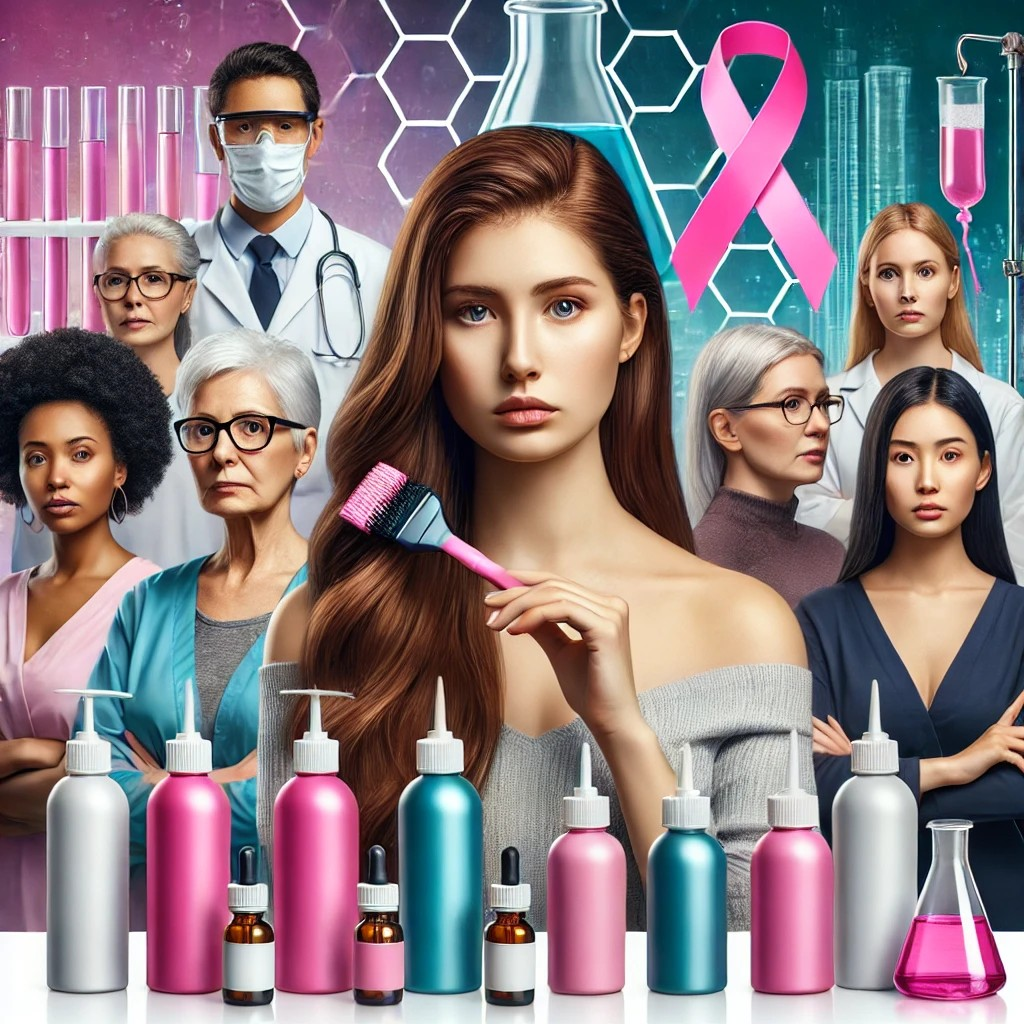Hair products have long been a staple in beauty routines, but recent studies have raised concerns about their safety. Specifically, research has suggested a potential link between the use of hair dyes and chemical hair relaxers and an increased risk of breast cancer, uterine cancer, and other hormone-related cancers. Studies have found that women who used hair relaxers more than four times in the previous year were over twice as likely to develop uterine cancer compared to those who did not use them. This has understandably caused worry among many individuals who regularly use these products. While the exact relationship between hair products and cancer remains under investigation, it is crucial to understand the possible risks and what steps can be taken to minimize them.
Mass Tort America is dedicated to keeping you informed about significant health concerns and potential legal actions related to harmful products. If you or a loved one has been affected by health issues potentially linked to hair dyes or chemical hair relaxers, we can help you explore your legal options. Our team is experienced in mass tort cases and is here to assist you in understanding your rights and pursuing the compensation you may deserve.
Understanding The Potential Risks
Studies have shown that certain chemicals in hair dyes and chemical hair relaxers could be harmful. Some of these products contain endocrine-disrupting chemicals (EDCs), which can interfere with hormone function. Hormones play a critical role in the development and progression of breast cancer, and exposure to EDCs may increase the risk of developing this disease. Additionally, the use of hair relaxers has been linked to an increased risk of endometrial cancer among Black women, with higher mortality rates and disparities in survival rates. The chemicals in these products are associated with the development of endometrial tumors. For example, phthalates, parabens, and some types of amines found in hair dyes have been scrutinized for their potential links to ovarian cancer.
The National Institutes of Health (NIH) conducted a study revealing that women who frequently use permanent hair dye and chemical hair straighteners have a higher risk of developing breast cancer than those who do not use these products. The study highlighted that this risk is more pronounced in Black women, who are more likely to use such products regularly. This racial disparity in product use and risk underscores the need for tailored public health strategies and regulations.
Despite these findings, it is important to note that not all hair products carry the same level of risk. Temporary dyes and natural hair care alternatives might pose fewer health hazards. Consumers should be aware of the ingredients in their hair products and opt for those with safer, non-toxic formulations whenever possible.
Analyzing The Research
The link between hair dyes, relaxers, and breast cancer is supported by various scientific studies, yet there is still much to learn. The NIH study, part of the larger Sister Study, followed over 46,000 women for more than eight years. The findings showed that women who used permanent hair dye had a 9% increased risk of breast cancer, while those who used chemical straighteners had an 18% higher risk of cause cancer. These statistics are significant, suggesting a need for further investigation and potential regulatory action.
However, it is also crucial to consider the limitations of these studies. Factors such identify risk factors such as genetics, lifestyle, and overall health can also influence breast cancer risk. For instance, family history and genetic mutations like BRCA1 and BRCA2 play substantial roles in an individual’s cancer risk. Additionally, lifestyle factors such as diet, exercise, and alcohol consumption are also important to consider.
Researchers continue to study the specific chemicals in hair products to determine which ones pose the most significant risks. By identifying the harmful ingredients, safer alternatives can be developed, and consumers can make more informed choices. Regulatory agencies may also use this information to set stricter safety standards for hair care products.
Chemicals Of Concern In Hair Products
One of the main concerns about hair dyes and relaxers is the presence of potentially harmful chemicals. Common chemicals found in hair dyes include ammonia, hydrogen peroxide, and p-phenylenediamine (PPD). These chemicals can cause skin irritation and allergic reactions, but their long-term health effects are of greater concern. PPD, in particular, has been studied for its potential carcinogenic properties.
Hair relaxers often contain strong chemicals like sodium hydroxide, guanidine hydroxide, and formaldehyde. These substances can cause scalp burns and hair damage, and prolonged exposure may increase the risk of cancer. Formaldehyde is classified as a human carcinogen, and its presence in hair straightening products has led to increased scrutiny and regulation.
The impact of these chemicals can vary based on how frequently the products are used and how they are applied. Regular users and salon workers who are frequently exposed to these substances might face higher risks. This highlights the importance of protective measures and safer product formulations to reduce exposure to harmful chemicals.
Health Disparities And Hair Product Use
Health disparities play a significant role in the context of hair product use and breast cancer risk. Black women are more likely than white women to use hair relaxers and permanent hair dyes, which may contribute to their higher breast cancer risk. Cultural beauty standards and societal pressures often influence these choices, leading to increased exposure to harmful chemicals.
Socioeconomic factors also contribute to health disparities. Access to safer, less toxic hair care products can be limited for low-income individuals, making them more vulnerable to health risks associated with chemical-laden products. Additionally, there is often a lack of awareness and education about the potential dangers of these products within underserved communities.
Addressing these disparities requires targeted public health interventions and policies that promote access to safe hair care alternatives. Community outreach and education programs can help raise awareness about hair products contribute and the risks and encourage healthier choices. Furthermore, regulatory actions to ensure safer product formulations can protect vulnerable populations from harmful exposures.
Regulatory Landscape And Consumer Protection
The regulation of hair care products varies by country, with some regions enforcing stricter standards than others. In the United States, the Food and Drug Administration (FDA) oversees the safety of cosmetics, including hair dyes and relaxers. However, the FDA does not require pre-market approval for cosmetics, meaning that many products reach the market without rigorous safety testing.
There have been calls for stronger regulations to ensure the safety of hair care products. Advocates argue for mandatory safety testing, clearer labeling of ingredients, and restrictions on harmful chemicals. Some states have taken the initiative to implement stricter regulations, such as banning the use of formaldehyde in hair straightening products.
Consumer protection also relies on informed choices and advocacy. Organizations such as the Environmental Working Group (EWG) offer resources and databases that assist consumers in identifying safer products. Increased transparency and accountability in the beauty industry can drive the development of safer alternatives and reduce health risks.
Exploring Safer Alternatives
For those concerned about the potential risks of hair dyes and relaxers, there are safer alternatives available. Natural hair dyes, such as henna, indigo, and vegetable-based dyes, offer a chemical-free option for coloring hair. These products are less likely to cause allergic reactions and do not contain the harmful substances found in conventional dyes.
In terms of hair straightening, non-chemical methods to straight hair like heat styling and keratin treatments can provide similar results without the use of harsh chemicals. However, it is important to use heat styling tools correctly to avoid hair damage. Additionally, there are many hair care products on the market that are formulated without parabens, sulfates, and other harmful chemicals.
Consumers can also embrace their natural hair texture as a way to avoid the risks associated with chemical relaxers and dyes. The natural hair movement has gained popularity in recent years, promoting the beauty and health benefits of wearing natural hair. This trend not only reduces exposure to harmful chemicals but also empowers individuals to embrace their unique hair textures.
The Role Of Healthcare Providers
Healthcare providers play a crucial role in educating patients about the potential risks of hair dyes and relaxers. Dermatologists, oncologists, and primary care physicians can provide valuable information on how to minimize exposure to harmful chemicals and promote overall health. Regular screenings and monitoring for breast cancer are essential, especially for those with higher risk factors.
Providers can also guide patients in choosing safer hair care products and practices. Recommending products with fewer harmful chemicals and encouraging natural hair care methods can help reduce health risks. Additionally, healthcare professionals can advocate for stronger regulations and support public health initiatives aimed at reducing exposure to toxic substances.
Collaboration between healthcare providers, researchers, and regulatory agencies is vital to understanding and addressing the health risks associated with hair dyes and relaxers. By working together, these stakeholders can develop strategies to protect public health and promote safer beauty practices.
Future Directions In Research And Policy
Ongoing research is essential to fully understand the link between hair dyes, relaxers, and breast cancer. Scientists continue to study more research the specific chemicals involved and their effects on health. Longitudinal studies and more comprehensive data collection can provide deeper insights into the risks and help identify safer alternatives.
Policy changes are also needed to enhance consumer safety. Advocates are pushing for stronger regulations that mandate safety testing and clearer labeling of hair care products. By holding manufacturers accountable and ensuring that only safe products reach the market, policymakers can protect public health.
Public awareness and education are equally important. Efforts to inform consumers about the potential risks and safer alternatives can lead to healthier choices and reduce exposure to harmful chemicals. Community outreach and engagement can also help address health disparities and promote equity in health outcomes.
Health Disparities And Cancer Risk
The relationship between hair products and cancer risk highlights significant health disparities. Black women, who use hair relaxers and dyes more frequently, face a higher risk of developing breast cancer. This disparity is not just due to product use but also because of socioeconomic factors that limit access to safer alternatives. Additionally, cultural norms and beauty standards contribute to the frequent use of these products.
Research from the National Cancer Institute and Boston University’s Black Women’s Health Study has shown that Black women using chemical hair straighteners are at increased risk for breast cancer and other hormone-related cancers, including some endometrial cancers and ovarian cancers. These studies underscore the need for targeted public health initiatives that address the unique risks faced by different populations.
Efforts to reduce these disparities include community outreach and education about safer hair care practices and products. By promoting the natural hair movement and increasing access to non-toxic hair products, it is possible to reduce the health risks associated with chemical hair relaxers and dyes. Regulatory policies that protect consumers from harmful chemicals are also essential in addressing these health disparities.
Hair Relaxers And Uterine Cancer Risk
Hair relaxers have been linked to an increased risk of uterine cancer, a relatively rare but serious type of cancer. The use of hair straightening chemicals, which often contain endocrine-disrupting chemicals, has been associated with a higher incidence of uterine cancer. Women who frequently use these products, especially Black women, are at a higher risk of developing uterine cancer.
Research published in Cancer Epidemiology Group studies and other scientific journals has found that frequent users of chemical hair relaxers have a higher risk of uterine cancer compared to those who do not use these products. These studies suggest that exposure to harmful chemicals in hair relaxers can disrupt hormonal balance and contribute to incident uterine cancer in development.
To mitigate these risks, researchers found it is important to identify safer alternatives and educate consumers about the potential dangers of chemical hair relaxers. Encouraging the use of natural hair styles and protective styles can help reduce exposure to harmful chemicals. Additionally, healthcare providers should monitor patients who use these products and provide guidance on safer hair care practices.
Legal Actions And Consumer Rights
The growing body of research linking hair relaxers to cancer has led to an increase in hair relaxer lawsuits. Individuals who have developed health problems, such as breast cancer or uterine cancer, after using these products are seeking legal recourse. These lawsuits aim to hold manufacturers used hair relaxers accountable for failing to warn consumers about the potential risks of their products.
Mass Tort America is actively involved in representing clients in hair relaxer lawsuits. By pursuing legal action, affected individuals can seek compensation for medical expenses, pain and suffering, and other damages. These lawsuits also serve to raise awareness about the risks associated with chemical hair relaxers and push for safer product formulations.
If you have used both hair relaxer and cancer products and developed cancer, you may be eligible to participate in a hair relaxer lawsuit. It is important to document your product use and health conditions and seek legal advice to understand your rights. Legal representation can help you navigate the complex legal process and pursue the compensation you deserve.
Preventive Measures And Public Health
Preventive measures are crucial in reducing the risks associated with hair relaxers and other hair products. Public health initiatives should focus on educating consumers about the dangers of certain chemicals found in these products and promoting safer alternatives. Regular screenings and health monitoring are also important for early detection and treatment of cancer.
Healthcare providers play a key role in prevention by advising patients on safe hair care practices and monitoring for signs of cancer. Recommending products free from harmful chemicals and encouraging natural hair styles can significantly reduce cancer risks. Additionally, healthcare professionals should advocate for stronger regulations and support public health policies that protect consumers.
By promoting awareness and preventive measures, it is possible to reduce the health risks associated with hair relaxers and other chemical hair straighteners. Collaboration between healthcare providers, researchers, regulatory agencies, and consumer advocacy groups is essential in creating a safer environment for all individuals.
Why Choose Mass Tort America To Address Your Concerns?
At Mass Tort America, we are committed to advocating for those affected by harmful products. Our team has extensive experience handling cases related to toxic exposures, including those potentially linked to hair dyes and relaxers. We understand the complexities of these cases and are dedicated to helping you navigate the legal process to seek justice and compensation.
Our Concierge Team is available to assist clients from all over the nation, coordinating necessary steps and providing support throughout the legal process. We strive to ensure that our clients receive the best possible representation and care. If you believe that your health has been compromised due to the use of hair dyes or relaxers, contact Mass Tort America today at 800-356-4338 or visit our contact form at https://masstortamerica.com/contact/.
Mass Tort America is here to provide the expertise and support you need. We are dedicated to holding manufacturers accountable and ensuring that your rights are protected. Reach out to us today to discuss your case and learn more about how we can help you achieve the justice and compensation you deserve.



















